Comprehensive X-Ray Physics: Path of the Beam Report
VerifiedAdded on 2022/08/22
|12
|2801
|34
Report
AI Summary
This report provides a comprehensive overview of X-ray physics, beginning with an introduction to atomic and nuclear physics, including the properties of atoms, electrons, and electromagnetic radiation, with a specific focus on X-rays. It then delves into electrostatics, explaining electric charges, conductors, and insulators. The report further explores electricity and magnetism, including electromagnetism and transformers. A detailed explanation of the components and function of an X-ray tube is also provided. Finally, the report concludes with a discussion of the interactions between X-rays and matter, particularly as it relates to the field of radiography. The report covers the path of the beam, which includes production, properties, and interactions of X-rays. The report also includes diagrams and references to support the presented information.

Running head: Path of the beam 1
Path of the beam
Student Name
Student Registration Number
Institution
Path of the beam
Student Name
Student Registration Number
Institution
Paraphrase This Document
Need a fresh take? Get an instant paraphrase of this document with our AI Paraphraser
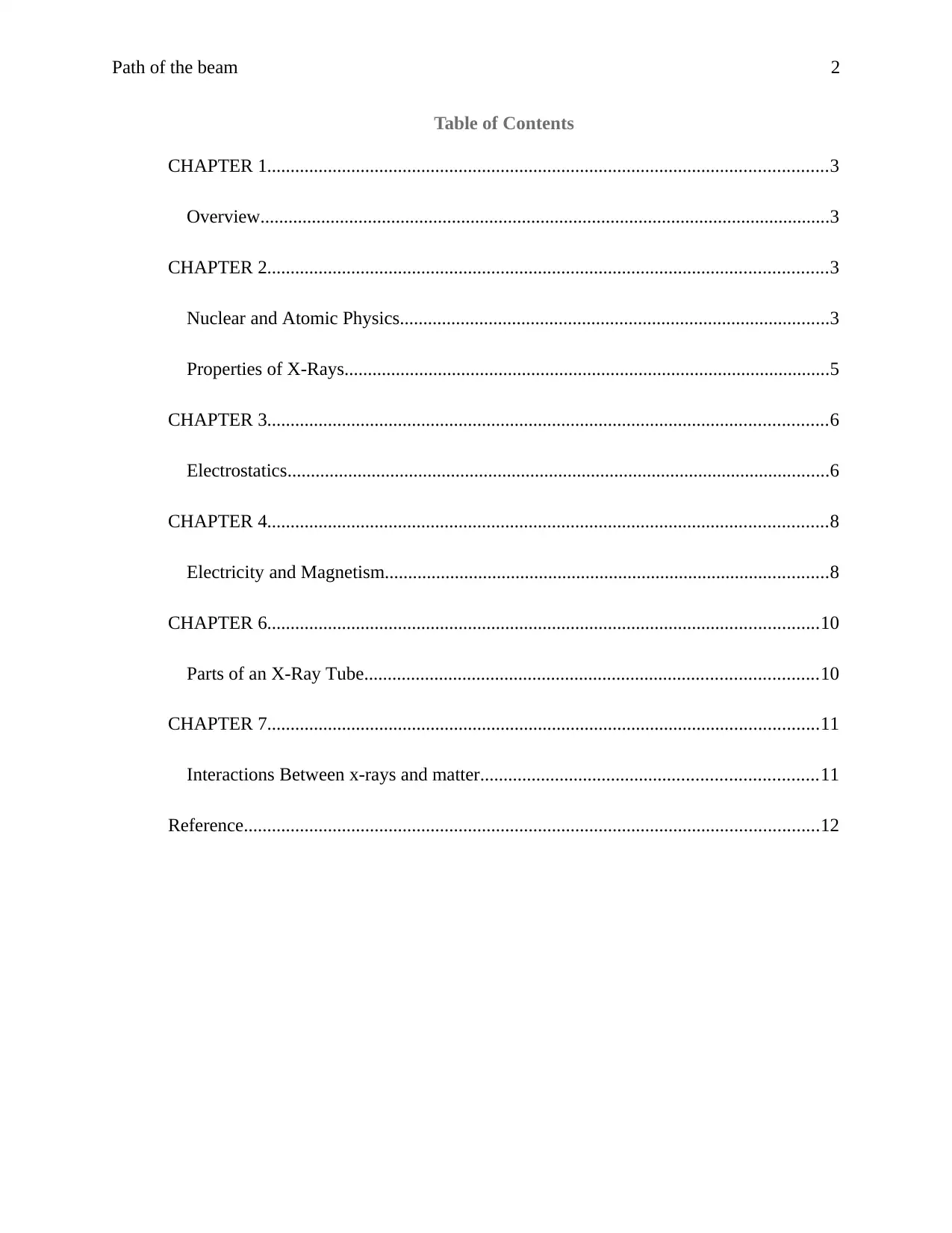
Path of the beam 2
Table of Contents
CHAPTER 1........................................................................................................................3
Overview..........................................................................................................................3
CHAPTER 2........................................................................................................................3
Nuclear and Atomic Physics............................................................................................3
Properties of X-Rays........................................................................................................5
CHAPTER 3........................................................................................................................6
Electrostatics....................................................................................................................6
CHAPTER 4........................................................................................................................8
Electricity and Magnetism...............................................................................................8
CHAPTER 6......................................................................................................................10
Parts of an X-Ray Tube.................................................................................................10
CHAPTER 7......................................................................................................................11
Interactions Between x-rays and matter........................................................................11
Reference...........................................................................................................................12
Table of Contents
CHAPTER 1........................................................................................................................3
Overview..........................................................................................................................3
CHAPTER 2........................................................................................................................3
Nuclear and Atomic Physics............................................................................................3
Properties of X-Rays........................................................................................................5
CHAPTER 3........................................................................................................................6
Electrostatics....................................................................................................................6
CHAPTER 4........................................................................................................................8
Electricity and Magnetism...............................................................................................8
CHAPTER 6......................................................................................................................10
Parts of an X-Ray Tube.................................................................................................10
CHAPTER 7......................................................................................................................11
Interactions Between x-rays and matter........................................................................11
Reference...........................................................................................................................12
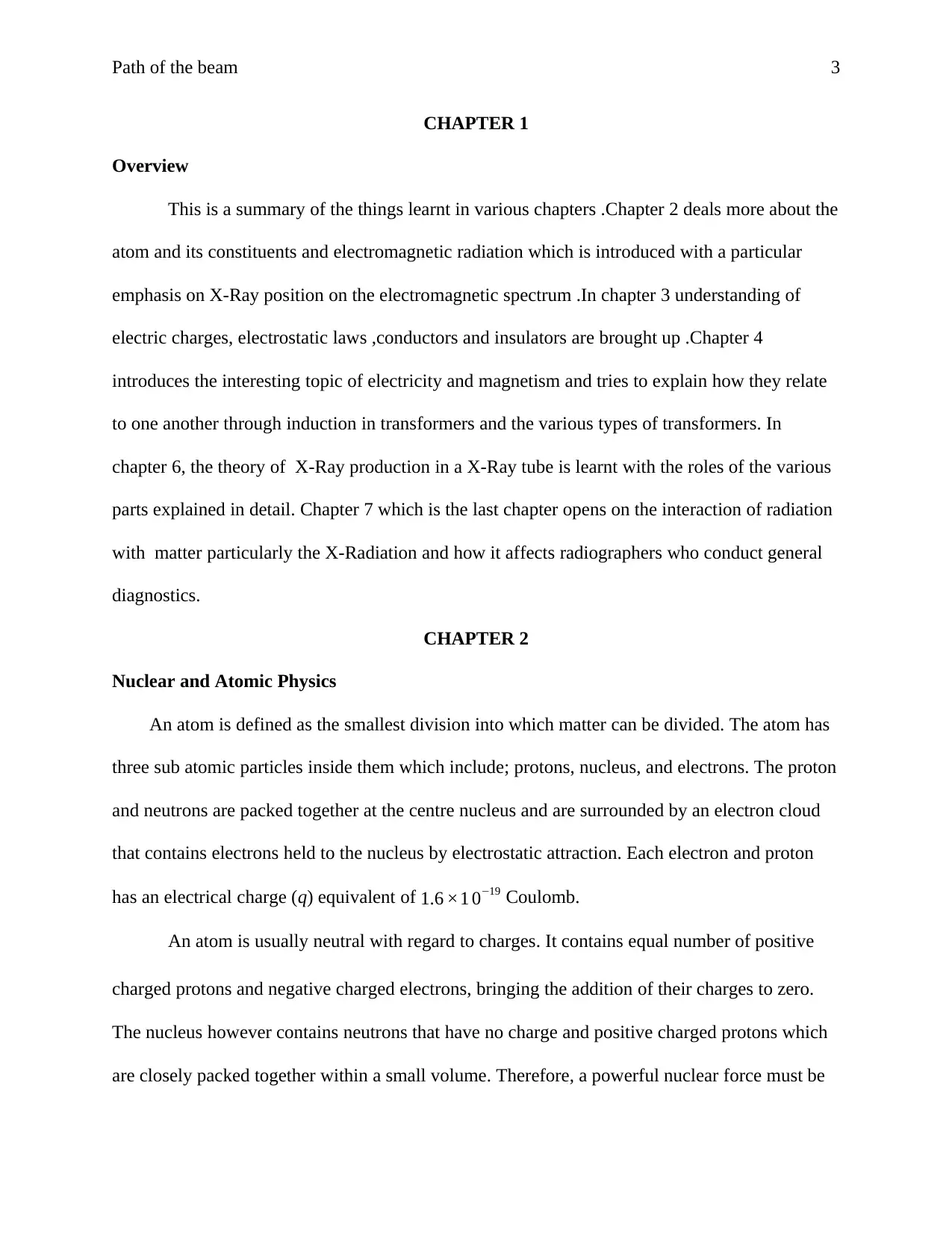
Path of the beam 3
CHAPTER 1
Overview
This is a summary of the things learnt in various chapters .Chapter 2 deals more about the
atom and its constituents and electromagnetic radiation which is introduced with a particular
emphasis on X-Ray position on the electromagnetic spectrum .In chapter 3 understanding of
electric charges, electrostatic laws ,conductors and insulators are brought up .Chapter 4
introduces the interesting topic of electricity and magnetism and tries to explain how they relate
to one another through induction in transformers and the various types of transformers. In
chapter 6, the theory of X-Ray production in a X-Ray tube is learnt with the roles of the various
parts explained in detail. Chapter 7 which is the last chapter opens on the interaction of radiation
with matter particularly the X-Radiation and how it affects radiographers who conduct general
diagnostics.
CHAPTER 2
Nuclear and Atomic Physics
An atom is defined as the smallest division into which matter can be divided. The atom has
three sub atomic particles inside them which include; protons, nucleus, and electrons. The proton
and neutrons are packed together at the centre nucleus and are surrounded by an electron cloud
that contains electrons held to the nucleus by electrostatic attraction. Each electron and proton
has an electrical charge (q) equivalent of 1.6 ×1 0−19 Coulomb.
An atom is usually neutral with regard to charges. It contains equal number of positive
charged protons and negative charged electrons, bringing the addition of their charges to zero.
The nucleus however contains neutrons that have no charge and positive charged protons which
are closely packed together within a small volume. Therefore, a powerful nuclear force must be
CHAPTER 1
Overview
This is a summary of the things learnt in various chapters .Chapter 2 deals more about the
atom and its constituents and electromagnetic radiation which is introduced with a particular
emphasis on X-Ray position on the electromagnetic spectrum .In chapter 3 understanding of
electric charges, electrostatic laws ,conductors and insulators are brought up .Chapter 4
introduces the interesting topic of electricity and magnetism and tries to explain how they relate
to one another through induction in transformers and the various types of transformers. In
chapter 6, the theory of X-Ray production in a X-Ray tube is learnt with the roles of the various
parts explained in detail. Chapter 7 which is the last chapter opens on the interaction of radiation
with matter particularly the X-Radiation and how it affects radiographers who conduct general
diagnostics.
CHAPTER 2
Nuclear and Atomic Physics
An atom is defined as the smallest division into which matter can be divided. The atom has
three sub atomic particles inside them which include; protons, nucleus, and electrons. The proton
and neutrons are packed together at the centre nucleus and are surrounded by an electron cloud
that contains electrons held to the nucleus by electrostatic attraction. Each electron and proton
has an electrical charge (q) equivalent of 1.6 ×1 0−19 Coulomb.
An atom is usually neutral with regard to charges. It contains equal number of positive
charged protons and negative charged electrons, bringing the addition of their charges to zero.
The nucleus however contains neutrons that have no charge and positive charged protons which
are closely packed together within a small volume. Therefore, a powerful nuclear force must be
⊘ This is a preview!⊘
Do you want full access?
Subscribe today to unlock all pages.

Trusted by 1+ million students worldwide
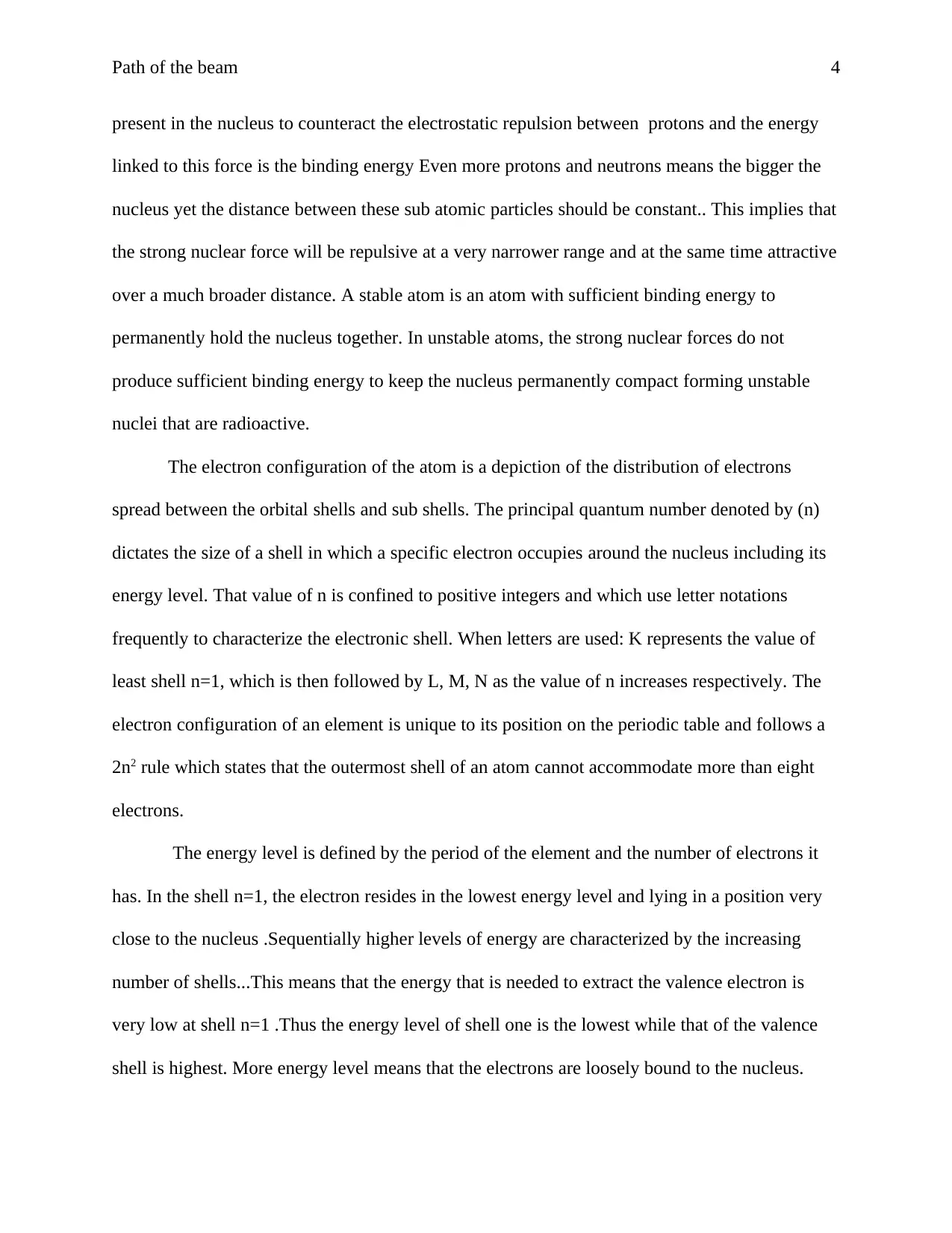
Path of the beam 4
present in the nucleus to counteract the electrostatic repulsion between protons and the energy
linked to this force is the binding energy Even more protons and neutrons means the bigger the
nucleus yet the distance between these sub atomic particles should be constant.. This implies that
the strong nuclear force will be repulsive at a very narrower range and at the same time attractive
over a much broader distance. A stable atom is an atom with sufficient binding energy to
permanently hold the nucleus together. In unstable atoms, the strong nuclear forces do not
produce sufficient binding energy to keep the nucleus permanently compact forming unstable
nuclei that are radioactive.
The electron configuration of the atom is a depiction of the distribution of electrons
spread between the orbital shells and sub shells. The principal quantum number denoted by (n)
dictates the size of a shell in which a specific electron occupies around the nucleus including its
energy level. That value of n is confined to positive integers and which use letter notations
frequently to characterize the electronic shell. When letters are used: K represents the value of
least shell n=1, which is then followed by L, M, N as the value of n increases respectively. The
electron configuration of an element is unique to its position on the periodic table and follows a
2n2 rule which states that the outermost shell of an atom cannot accommodate more than eight
electrons.
The energy level is defined by the period of the element and the number of electrons it
has. In the shell n=1, the electron resides in the lowest energy level and lying in a position very
close to the nucleus .Sequentially higher levels of energy are characterized by the increasing
number of shells...This means that the energy that is needed to extract the valence electron is
very low at shell n=1 .Thus the energy level of shell one is the lowest while that of the valence
shell is highest. More energy level means that the electrons are loosely bound to the nucleus.
present in the nucleus to counteract the electrostatic repulsion between protons and the energy
linked to this force is the binding energy Even more protons and neutrons means the bigger the
nucleus yet the distance between these sub atomic particles should be constant.. This implies that
the strong nuclear force will be repulsive at a very narrower range and at the same time attractive
over a much broader distance. A stable atom is an atom with sufficient binding energy to
permanently hold the nucleus together. In unstable atoms, the strong nuclear forces do not
produce sufficient binding energy to keep the nucleus permanently compact forming unstable
nuclei that are radioactive.
The electron configuration of the atom is a depiction of the distribution of electrons
spread between the orbital shells and sub shells. The principal quantum number denoted by (n)
dictates the size of a shell in which a specific electron occupies around the nucleus including its
energy level. That value of n is confined to positive integers and which use letter notations
frequently to characterize the electronic shell. When letters are used: K represents the value of
least shell n=1, which is then followed by L, M, N as the value of n increases respectively. The
electron configuration of an element is unique to its position on the periodic table and follows a
2n2 rule which states that the outermost shell of an atom cannot accommodate more than eight
electrons.
The energy level is defined by the period of the element and the number of electrons it
has. In the shell n=1, the electron resides in the lowest energy level and lying in a position very
close to the nucleus .Sequentially higher levels of energy are characterized by the increasing
number of shells...This means that the energy that is needed to extract the valence electron is
very low at shell n=1 .Thus the energy level of shell one is the lowest while that of the valence
shell is highest. More energy level means that the electrons are loosely bound to the nucleus.
Paraphrase This Document
Need a fresh take? Get an instant paraphrase of this document with our AI Paraphraser
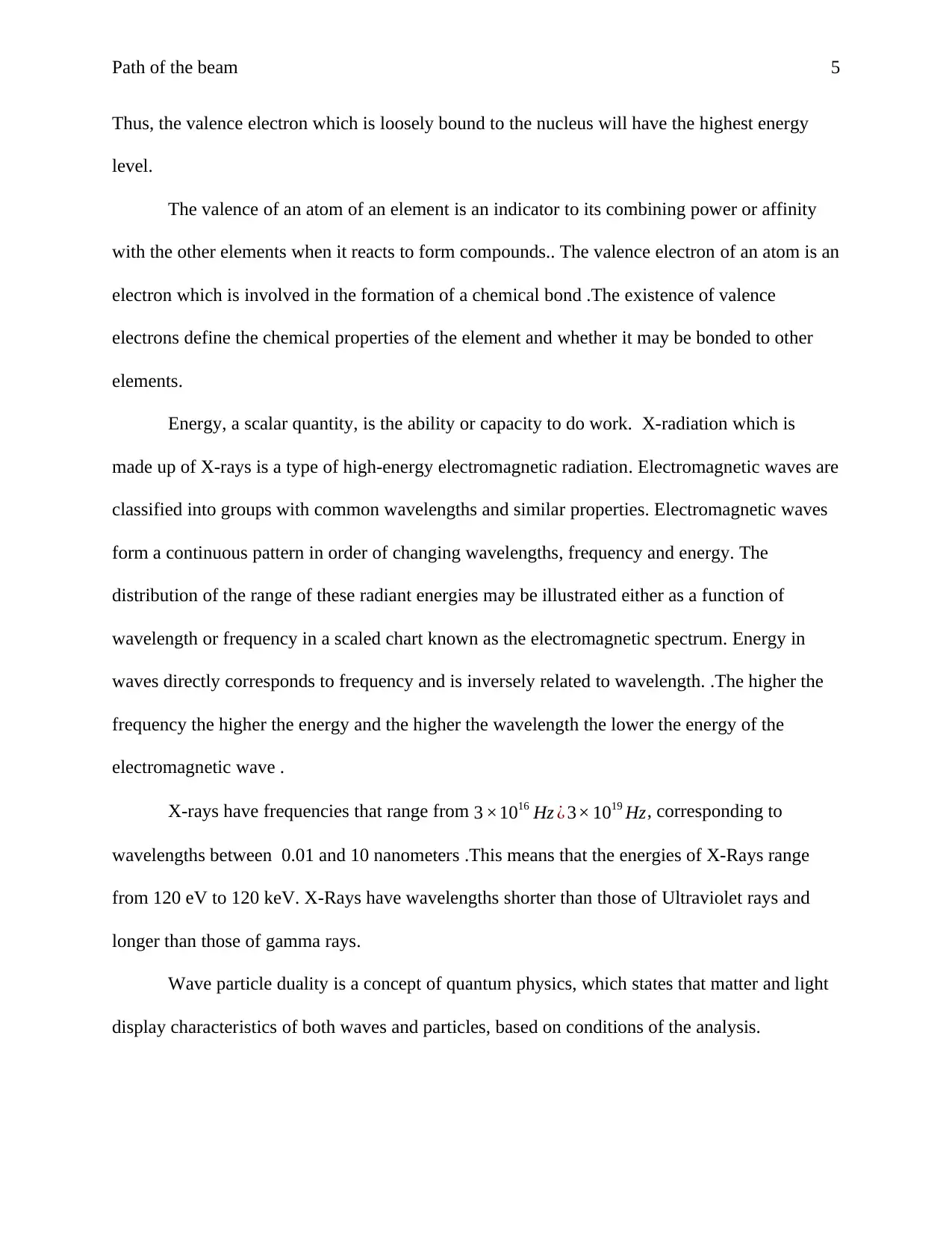
Path of the beam 5
Thus, the valence electron which is loosely bound to the nucleus will have the highest energy
level.
The valence of an atom of an element is an indicator to its combining power or affinity
with the other elements when it reacts to form compounds.. The valence electron of an atom is an
electron which is involved in the formation of a chemical bond .The existence of valence
electrons define the chemical properties of the element and whether it may be bonded to other
elements.
Energy, a scalar quantity, is the ability or capacity to do work. X-radiation which is
made up of X-rays is a type of high-energy electromagnetic radiation. Electromagnetic waves are
classified into groups with common wavelengths and similar properties. Electromagnetic waves
form a continuous pattern in order of changing wavelengths, frequency and energy. The
distribution of the range of these radiant energies may be illustrated either as a function of
wavelength or frequency in a scaled chart known as the electromagnetic spectrum. Energy in
waves directly corresponds to frequency and is inversely related to wavelength. .The higher the
frequency the higher the energy and the higher the wavelength the lower the energy of the
electromagnetic wave .
X-rays have frequencies that range from 3 ×1016 Hz ¿ 3× 1019 Hz, corresponding to
wavelengths between 0.01 and 10 nanometers .This means that the energies of X-Rays range
from 120 eV to 120 keV. X-Rays have wavelengths shorter than those of Ultraviolet rays and
longer than those of gamma rays.
Wave particle duality is a concept of quantum physics, which states that matter and light
display characteristics of both waves and particles, based on conditions of the analysis.
Thus, the valence electron which is loosely bound to the nucleus will have the highest energy
level.
The valence of an atom of an element is an indicator to its combining power or affinity
with the other elements when it reacts to form compounds.. The valence electron of an atom is an
electron which is involved in the formation of a chemical bond .The existence of valence
electrons define the chemical properties of the element and whether it may be bonded to other
elements.
Energy, a scalar quantity, is the ability or capacity to do work. X-radiation which is
made up of X-rays is a type of high-energy electromagnetic radiation. Electromagnetic waves are
classified into groups with common wavelengths and similar properties. Electromagnetic waves
form a continuous pattern in order of changing wavelengths, frequency and energy. The
distribution of the range of these radiant energies may be illustrated either as a function of
wavelength or frequency in a scaled chart known as the electromagnetic spectrum. Energy in
waves directly corresponds to frequency and is inversely related to wavelength. .The higher the
frequency the higher the energy and the higher the wavelength the lower the energy of the
electromagnetic wave .
X-rays have frequencies that range from 3 ×1016 Hz ¿ 3× 1019 Hz, corresponding to
wavelengths between 0.01 and 10 nanometers .This means that the energies of X-Rays range
from 120 eV to 120 keV. X-Rays have wavelengths shorter than those of Ultraviolet rays and
longer than those of gamma rays.
Wave particle duality is a concept of quantum physics, which states that matter and light
display characteristics of both waves and particles, based on conditions of the analysis.
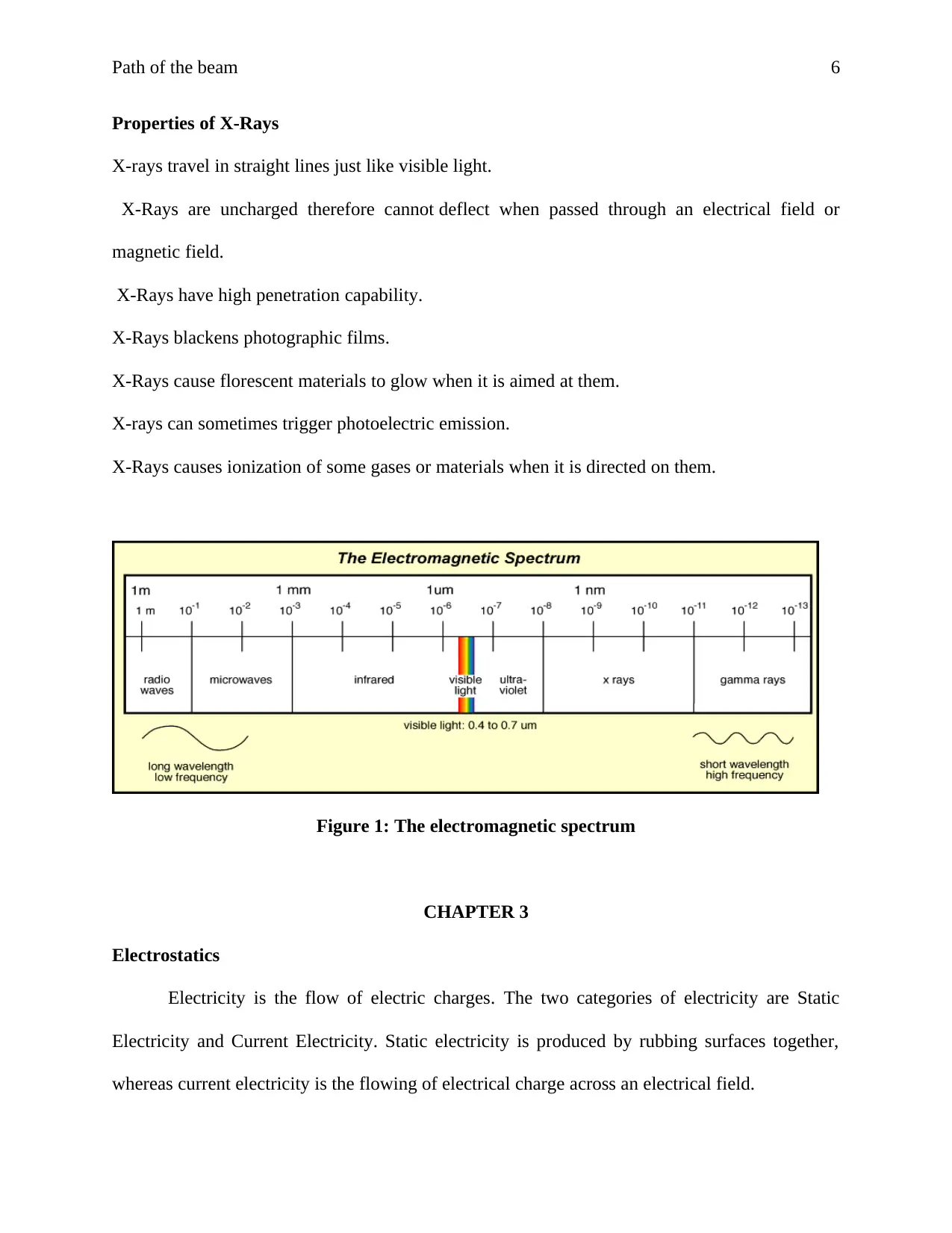
Path of the beam 6
Properties of X-Rays
X-rays travel in straight lines just like visible light.
X-Rays are uncharged therefore cannot deflect when passed through an electrical field or
magnetic field.
X-Rays have high penetration capability.
X-Rays blackens photographic films.
X-Rays cause florescent materials to glow when it is aimed at them.
X-rays can sometimes trigger photoelectric emission.
X-Rays causes ionization of some gases or materials when it is directed on them.
Figure 1: The electromagnetic spectrum
CHAPTER 3
Electrostatics
Electricity is the flow of electric charges. The two categories of electricity are Static
Electricity and Current Electricity. Static electricity is produced by rubbing surfaces together,
whereas current electricity is the flowing of electrical charge across an electrical field.
Properties of X-Rays
X-rays travel in straight lines just like visible light.
X-Rays are uncharged therefore cannot deflect when passed through an electrical field or
magnetic field.
X-Rays have high penetration capability.
X-Rays blackens photographic films.
X-Rays cause florescent materials to glow when it is aimed at them.
X-rays can sometimes trigger photoelectric emission.
X-Rays causes ionization of some gases or materials when it is directed on them.
Figure 1: The electromagnetic spectrum
CHAPTER 3
Electrostatics
Electricity is the flow of electric charges. The two categories of electricity are Static
Electricity and Current Electricity. Static electricity is produced by rubbing surfaces together,
whereas current electricity is the flowing of electrical charge across an electrical field.
⊘ This is a preview!⊘
Do you want full access?
Subscribe today to unlock all pages.

Trusted by 1+ million students worldwide
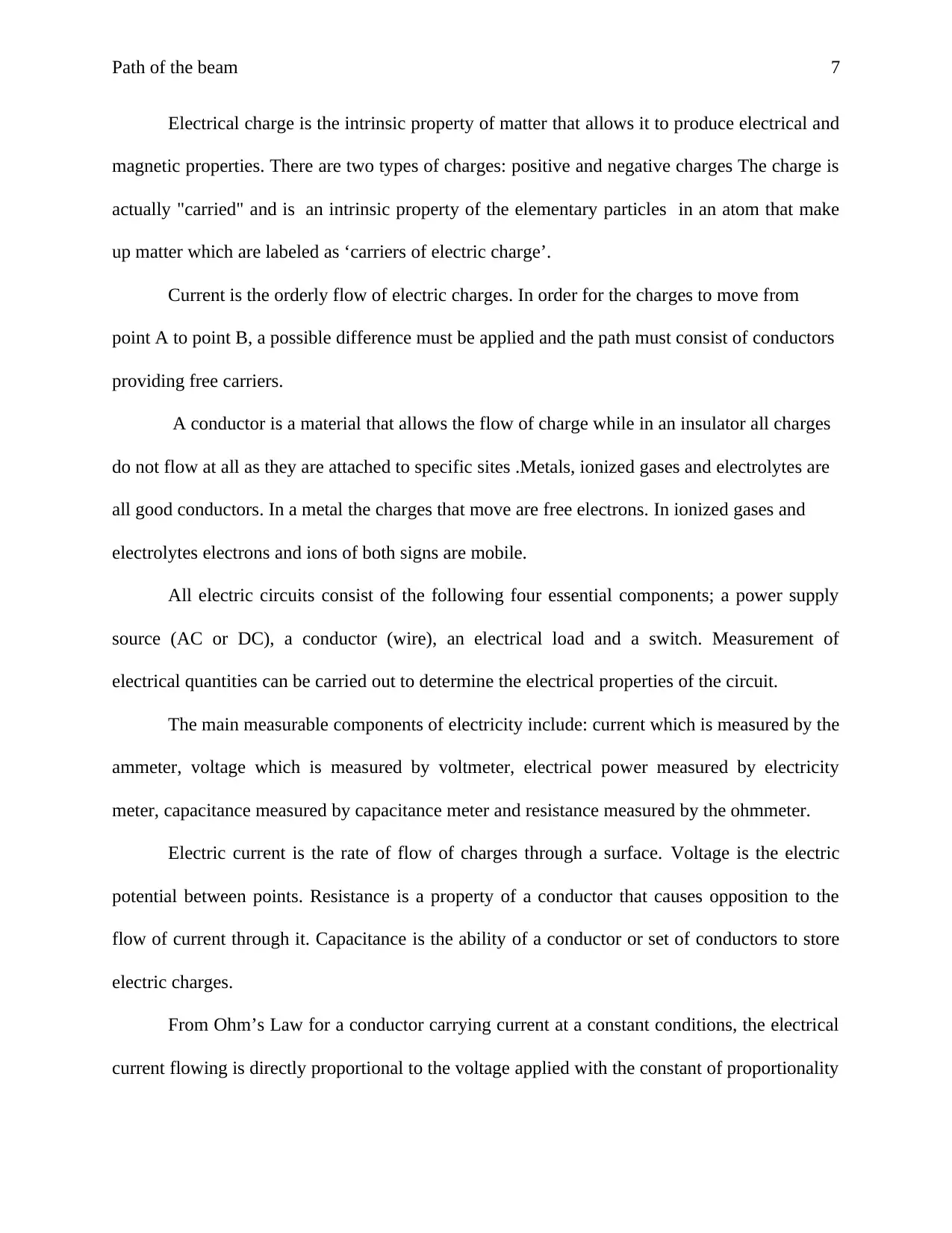
Path of the beam 7
Electrical charge is the intrinsic property of matter that allows it to produce electrical and
magnetic properties. There are two types of charges: positive and negative charges The charge is
actually "carried" and is an intrinsic property of the elementary particles in an atom that make
up matter which are labeled as ‘carriers of electric charge’.
Current is the orderly flow of electric charges. In order for the charges to move from
point A to point B, a possible difference must be applied and the path must consist of conductors
providing free carriers.
A conductor is a material that allows the flow of charge while in an insulator all charges
do not flow at all as they are attached to specific sites .Metals, ionized gases and electrolytes are
all good conductors. In a metal the charges that move are free electrons. In ionized gases and
electrolytes electrons and ions of both signs are mobile.
All electric circuits consist of the following four essential components; a power supply
source (AC or DC), a conductor (wire), an electrical load and a switch. Measurement of
electrical quantities can be carried out to determine the electrical properties of the circuit.
The main measurable components of electricity include: current which is measured by the
ammeter, voltage which is measured by voltmeter, electrical power measured by electricity
meter, capacitance measured by capacitance meter and resistance measured by the ohmmeter.
Electric current is the rate of flow of charges through a surface. Voltage is the electric
potential between points. Resistance is a property of a conductor that causes opposition to the
flow of current through it. Capacitance is the ability of a conductor or set of conductors to store
electric charges.
From Ohm’s Law for a conductor carrying current at a constant conditions, the electrical
current flowing is directly proportional to the voltage applied with the constant of proportionality
Electrical charge is the intrinsic property of matter that allows it to produce electrical and
magnetic properties. There are two types of charges: positive and negative charges The charge is
actually "carried" and is an intrinsic property of the elementary particles in an atom that make
up matter which are labeled as ‘carriers of electric charge’.
Current is the orderly flow of electric charges. In order for the charges to move from
point A to point B, a possible difference must be applied and the path must consist of conductors
providing free carriers.
A conductor is a material that allows the flow of charge while in an insulator all charges
do not flow at all as they are attached to specific sites .Metals, ionized gases and electrolytes are
all good conductors. In a metal the charges that move are free electrons. In ionized gases and
electrolytes electrons and ions of both signs are mobile.
All electric circuits consist of the following four essential components; a power supply
source (AC or DC), a conductor (wire), an electrical load and a switch. Measurement of
electrical quantities can be carried out to determine the electrical properties of the circuit.
The main measurable components of electricity include: current which is measured by the
ammeter, voltage which is measured by voltmeter, electrical power measured by electricity
meter, capacitance measured by capacitance meter and resistance measured by the ohmmeter.
Electric current is the rate of flow of charges through a surface. Voltage is the electric
potential between points. Resistance is a property of a conductor that causes opposition to the
flow of current through it. Capacitance is the ability of a conductor or set of conductors to store
electric charges.
From Ohm’s Law for a conductor carrying current at a constant conditions, the electrical
current flowing is directly proportional to the voltage applied with the constant of proportionality
Paraphrase This Document
Need a fresh take? Get an instant paraphrase of this document with our AI Paraphraser
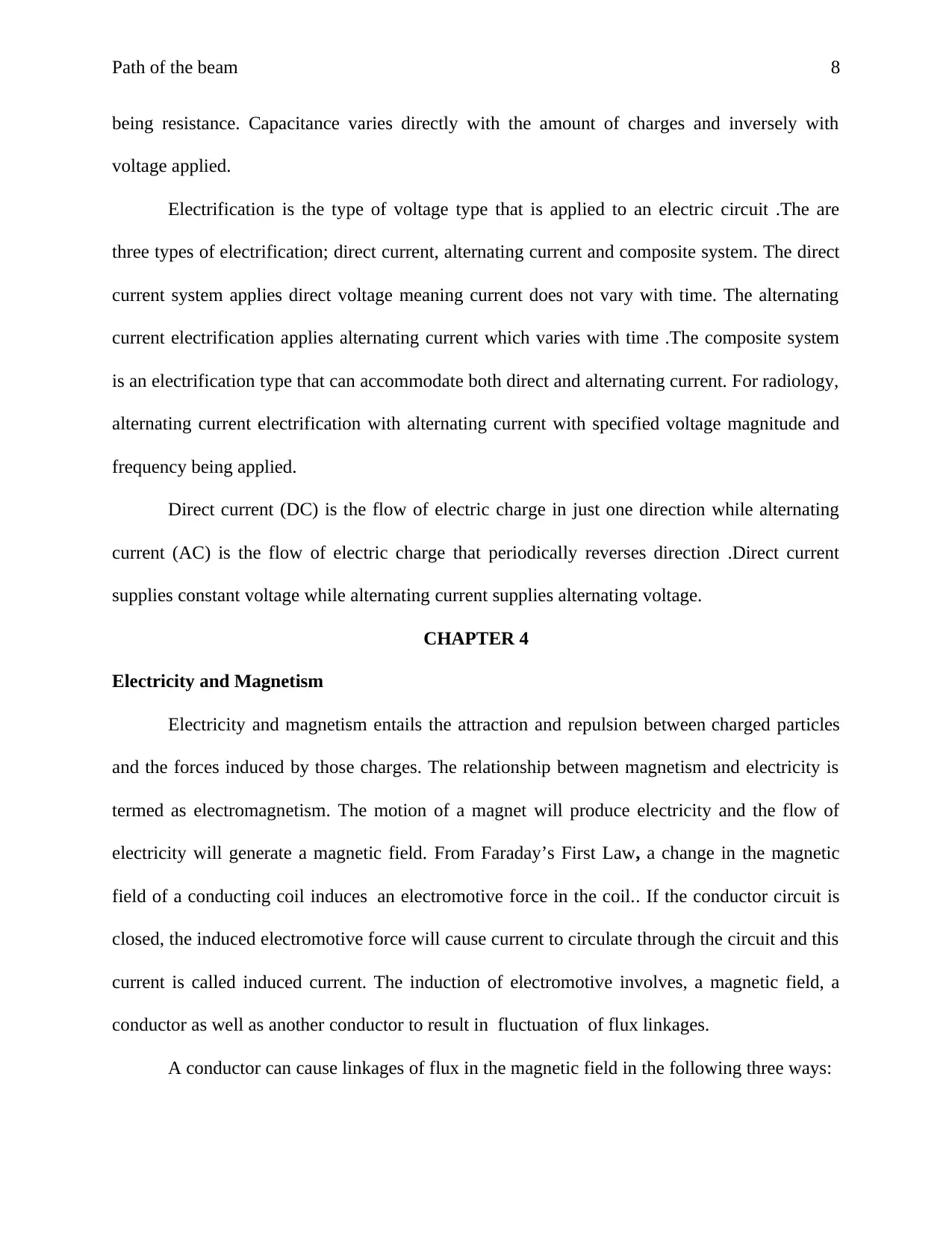
Path of the beam 8
being resistance. Capacitance varies directly with the amount of charges and inversely with
voltage applied.
Electrification is the type of voltage type that is applied to an electric circuit .The are
three types of electrification; direct current, alternating current and composite system. The direct
current system applies direct voltage meaning current does not vary with time. The alternating
current electrification applies alternating current which varies with time .The composite system
is an electrification type that can accommodate both direct and alternating current. For radiology,
alternating current electrification with alternating current with specified voltage magnitude and
frequency being applied.
Direct current (DC) is the flow of electric charge in just one direction while alternating
current (AC) is the flow of electric charge that periodically reverses direction .Direct current
supplies constant voltage while alternating current supplies alternating voltage.
CHAPTER 4
Electricity and Magnetism
Electricity and magnetism entails the attraction and repulsion between charged particles
and the forces induced by those charges. The relationship between magnetism and electricity is
termed as electromagnetism. The motion of a magnet will produce electricity and the flow of
electricity will generate a magnetic field. From Faraday’s First Law, a change in the magnetic
field of a conducting coil induces an electromotive force in the coil.. If the conductor circuit is
closed, the induced electromotive force will cause current to circulate through the circuit and this
current is called induced current. The induction of electromotive involves, a magnetic field, a
conductor as well as another conductor to result in fluctuation of flux linkages.
A conductor can cause linkages of flux in the magnetic field in the following three ways:
being resistance. Capacitance varies directly with the amount of charges and inversely with
voltage applied.
Electrification is the type of voltage type that is applied to an electric circuit .The are
three types of electrification; direct current, alternating current and composite system. The direct
current system applies direct voltage meaning current does not vary with time. The alternating
current electrification applies alternating current which varies with time .The composite system
is an electrification type that can accommodate both direct and alternating current. For radiology,
alternating current electrification with alternating current with specified voltage magnitude and
frequency being applied.
Direct current (DC) is the flow of electric charge in just one direction while alternating
current (AC) is the flow of electric charge that periodically reverses direction .Direct current
supplies constant voltage while alternating current supplies alternating voltage.
CHAPTER 4
Electricity and Magnetism
Electricity and magnetism entails the attraction and repulsion between charged particles
and the forces induced by those charges. The relationship between magnetism and electricity is
termed as electromagnetism. The motion of a magnet will produce electricity and the flow of
electricity will generate a magnetic field. From Faraday’s First Law, a change in the magnetic
field of a conducting coil induces an electromotive force in the coil.. If the conductor circuit is
closed, the induced electromotive force will cause current to circulate through the circuit and this
current is called induced current. The induction of electromotive involves, a magnetic field, a
conductor as well as another conductor to result in fluctuation of flux linkages.
A conductor can cause linkages of flux in the magnetic field in the following three ways:
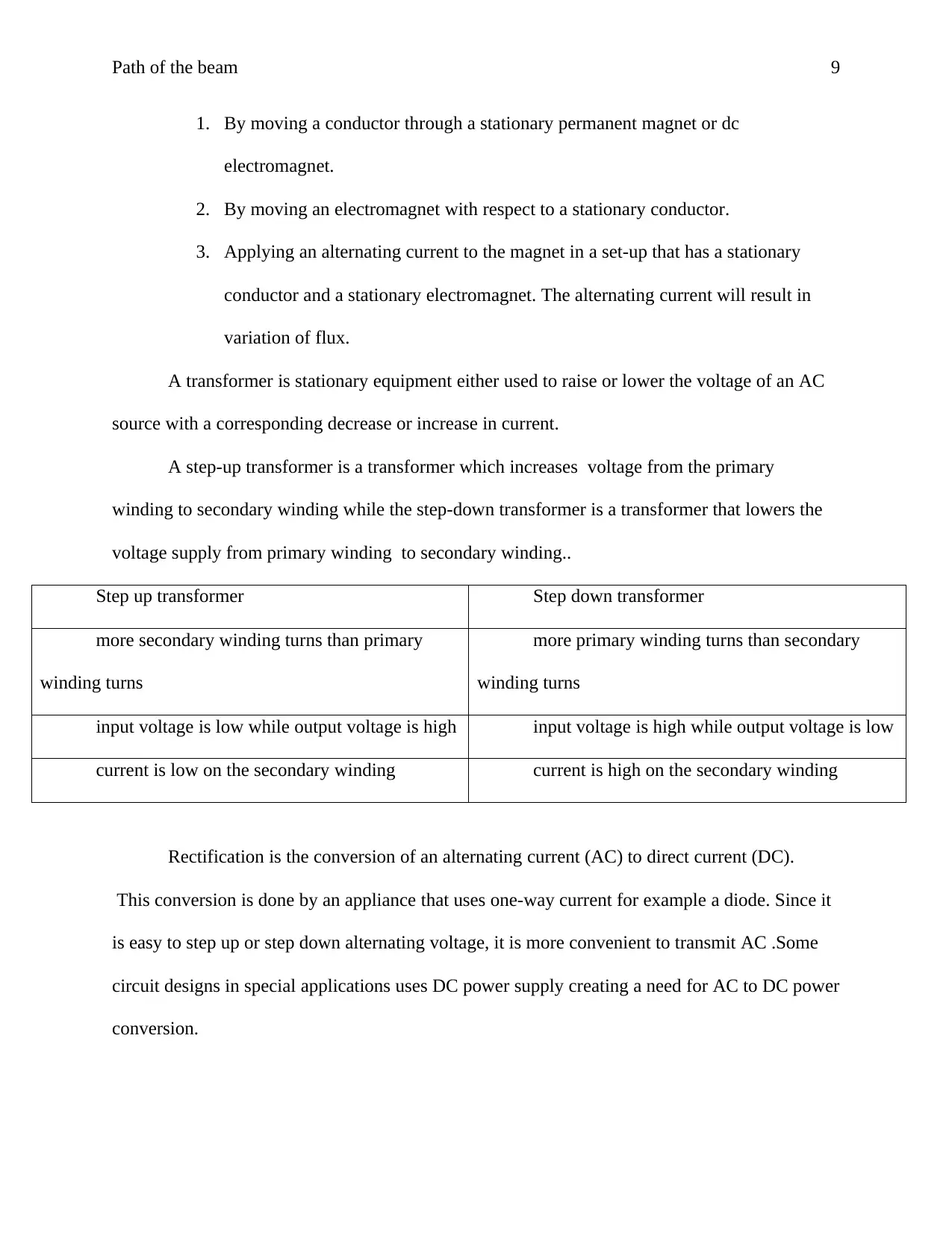
Path of the beam 9
1. By moving a conductor through a stationary permanent magnet or dc
electromagnet.
2. By moving an electromagnet with respect to a stationary conductor.
3. Applying an alternating current to the magnet in a set-up that has a stationary
conductor and a stationary electromagnet. The alternating current will result in
variation of flux.
A transformer is stationary equipment either used to raise or lower the voltage of an AC
source with a corresponding decrease or increase in current.
A step-up transformer is a transformer which increases voltage from the primary
winding to secondary winding while the step-down transformer is a transformer that lowers the
voltage supply from primary winding to secondary winding..
Step up transformer Step down transformer
more secondary winding turns than primary
winding turns
more primary winding turns than secondary
winding turns
input voltage is low while output voltage is high input voltage is high while output voltage is low
current is low on the secondary winding current is high on the secondary winding
Rectification is the conversion of an alternating current (AC) to direct current (DC).
This conversion is done by an appliance that uses one-way current for example a diode. Since it
is easy to step up or step down alternating voltage, it is more convenient to transmit AC .Some
circuit designs in special applications uses DC power supply creating a need for AC to DC power
conversion.
1. By moving a conductor through a stationary permanent magnet or dc
electromagnet.
2. By moving an electromagnet with respect to a stationary conductor.
3. Applying an alternating current to the magnet in a set-up that has a stationary
conductor and a stationary electromagnet. The alternating current will result in
variation of flux.
A transformer is stationary equipment either used to raise or lower the voltage of an AC
source with a corresponding decrease or increase in current.
A step-up transformer is a transformer which increases voltage from the primary
winding to secondary winding while the step-down transformer is a transformer that lowers the
voltage supply from primary winding to secondary winding..
Step up transformer Step down transformer
more secondary winding turns than primary
winding turns
more primary winding turns than secondary
winding turns
input voltage is low while output voltage is high input voltage is high while output voltage is low
current is low on the secondary winding current is high on the secondary winding
Rectification is the conversion of an alternating current (AC) to direct current (DC).
This conversion is done by an appliance that uses one-way current for example a diode. Since it
is easy to step up or step down alternating voltage, it is more convenient to transmit AC .Some
circuit designs in special applications uses DC power supply creating a need for AC to DC power
conversion.
⊘ This is a preview!⊘
Do you want full access?
Subscribe today to unlock all pages.

Trusted by 1+ million students worldwide
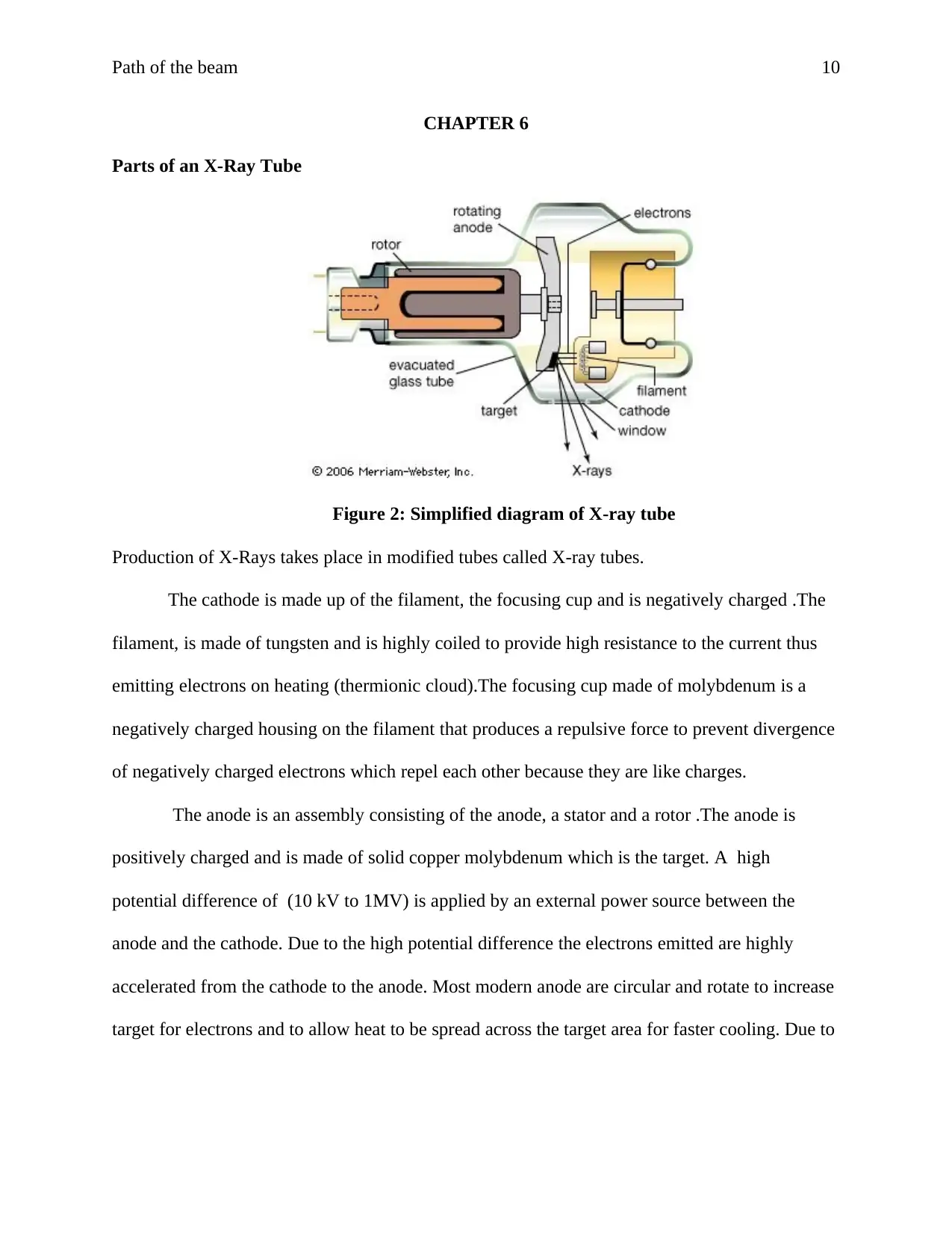
Path of the beam 10
CHAPTER 6
Parts of an X-Ray Tube
Figure 2: Simplified diagram of X-ray tube
Production of X-Rays takes place in modified tubes called X-ray tubes.
The cathode is made up of the filament, the focusing cup and is negatively charged .The
filament, is made of tungsten and is highly coiled to provide high resistance to the current thus
emitting electrons on heating (thermionic cloud).The focusing cup made of molybdenum is a
negatively charged housing on the filament that produces a repulsive force to prevent divergence
of negatively charged electrons which repel each other because they are like charges.
The anode is an assembly consisting of the anode, a stator and a rotor .The anode is
positively charged and is made of solid copper molybdenum which is the target. A high
potential difference of (10 kV to 1MV) is applied by an external power source between the
anode and the cathode. Due to the high potential difference the electrons emitted are highly
accelerated from the cathode to the anode. Most modern anode are circular and rotate to increase
target for electrons and to allow heat to be spread across the target area for faster cooling. Due to
CHAPTER 6
Parts of an X-Ray Tube
Figure 2: Simplified diagram of X-ray tube
Production of X-Rays takes place in modified tubes called X-ray tubes.
The cathode is made up of the filament, the focusing cup and is negatively charged .The
filament, is made of tungsten and is highly coiled to provide high resistance to the current thus
emitting electrons on heating (thermionic cloud).The focusing cup made of molybdenum is a
negatively charged housing on the filament that produces a repulsive force to prevent divergence
of negatively charged electrons which repel each other because they are like charges.
The anode is an assembly consisting of the anode, a stator and a rotor .The anode is
positively charged and is made of solid copper molybdenum which is the target. A high
potential difference of (10 kV to 1MV) is applied by an external power source between the
anode and the cathode. Due to the high potential difference the electrons emitted are highly
accelerated from the cathode to the anode. Most modern anode are circular and rotate to increase
target for electrons and to allow heat to be spread across the target area for faster cooling. Due to
Paraphrase This Document
Need a fresh take? Get an instant paraphrase of this document with our AI Paraphraser
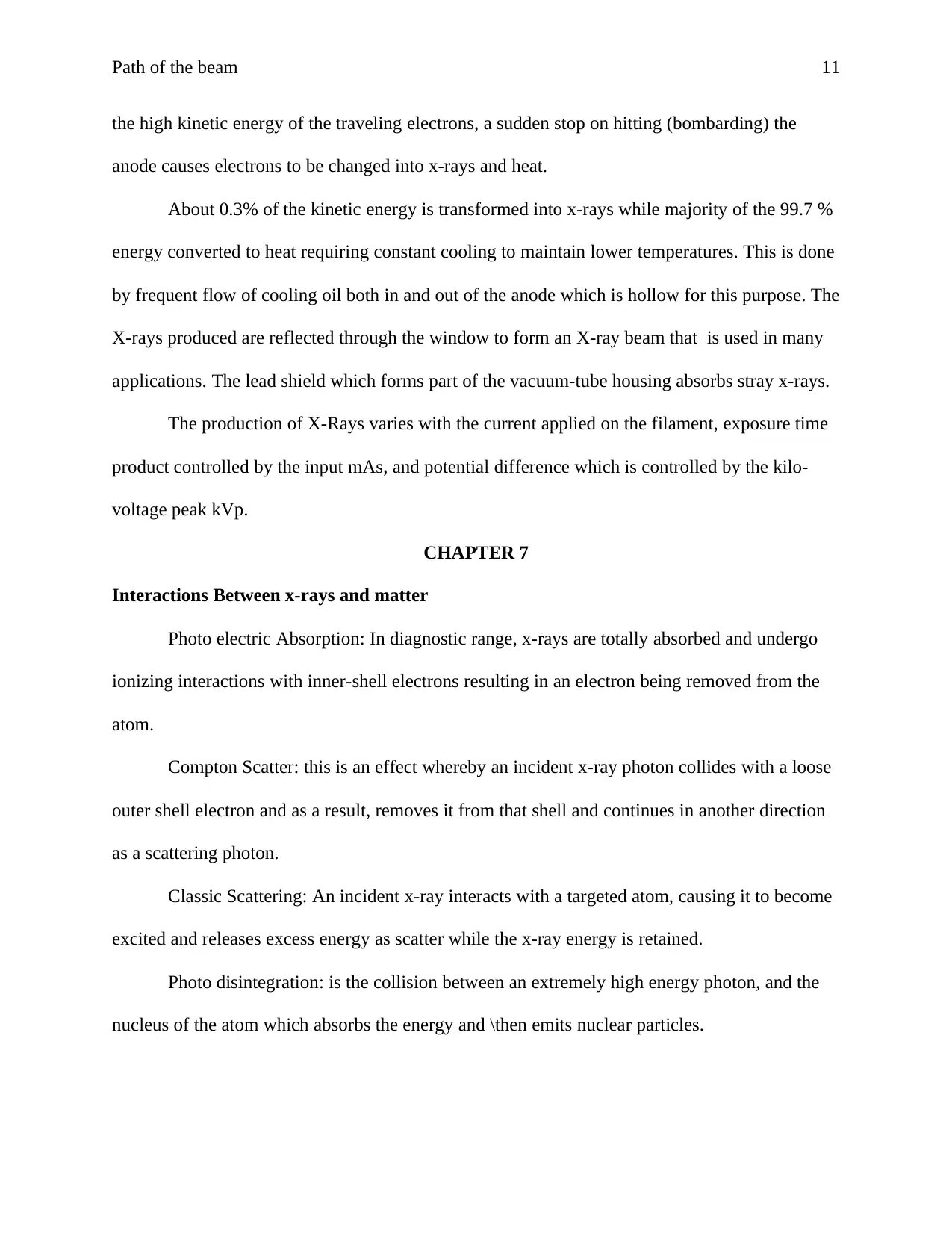
Path of the beam 11
the high kinetic energy of the traveling electrons, a sudden stop on hitting (bombarding) the
anode causes electrons to be changed into x-rays and heat.
About 0.3% of the kinetic energy is transformed into x-rays while majority of the 99.7 %
energy converted to heat requiring constant cooling to maintain lower temperatures. This is done
by frequent flow of cooling oil both in and out of the anode which is hollow for this purpose. The
X-rays produced are reflected through the window to form an X-ray beam that is used in many
applications. The lead shield which forms part of the vacuum-tube housing absorbs stray x-rays.
The production of X-Rays varies with the current applied on the filament, exposure time
product controlled by the input mAs, and potential difference which is controlled by the kilo-
voltage peak kVp.
CHAPTER 7
Interactions Between x-rays and matter
Photo electric Absorption: In diagnostic range, x-rays are totally absorbed and undergo
ionizing interactions with inner-shell electrons resulting in an electron being removed from the
atom.
Compton Scatter: this is an effect whereby an incident x-ray photon collides with a loose
outer shell electron and as a result, removes it from that shell and continues in another direction
as a scattering photon.
Classic Scattering: An incident x-ray interacts with a targeted atom, causing it to become
excited and releases excess energy as scatter while the x-ray energy is retained.
Photo disintegration: is the collision between an extremely high energy photon, and the
nucleus of the atom which absorbs the energy and \then emits nuclear particles.
the high kinetic energy of the traveling electrons, a sudden stop on hitting (bombarding) the
anode causes electrons to be changed into x-rays and heat.
About 0.3% of the kinetic energy is transformed into x-rays while majority of the 99.7 %
energy converted to heat requiring constant cooling to maintain lower temperatures. This is done
by frequent flow of cooling oil both in and out of the anode which is hollow for this purpose. The
X-rays produced are reflected through the window to form an X-ray beam that is used in many
applications. The lead shield which forms part of the vacuum-tube housing absorbs stray x-rays.
The production of X-Rays varies with the current applied on the filament, exposure time
product controlled by the input mAs, and potential difference which is controlled by the kilo-
voltage peak kVp.
CHAPTER 7
Interactions Between x-rays and matter
Photo electric Absorption: In diagnostic range, x-rays are totally absorbed and undergo
ionizing interactions with inner-shell electrons resulting in an electron being removed from the
atom.
Compton Scatter: this is an effect whereby an incident x-ray photon collides with a loose
outer shell electron and as a result, removes it from that shell and continues in another direction
as a scattering photon.
Classic Scattering: An incident x-ray interacts with a targeted atom, causing it to become
excited and releases excess energy as scatter while the x-ray energy is retained.
Photo disintegration: is the collision between an extremely high energy photon, and the
nucleus of the atom which absorbs the energy and \then emits nuclear particles.
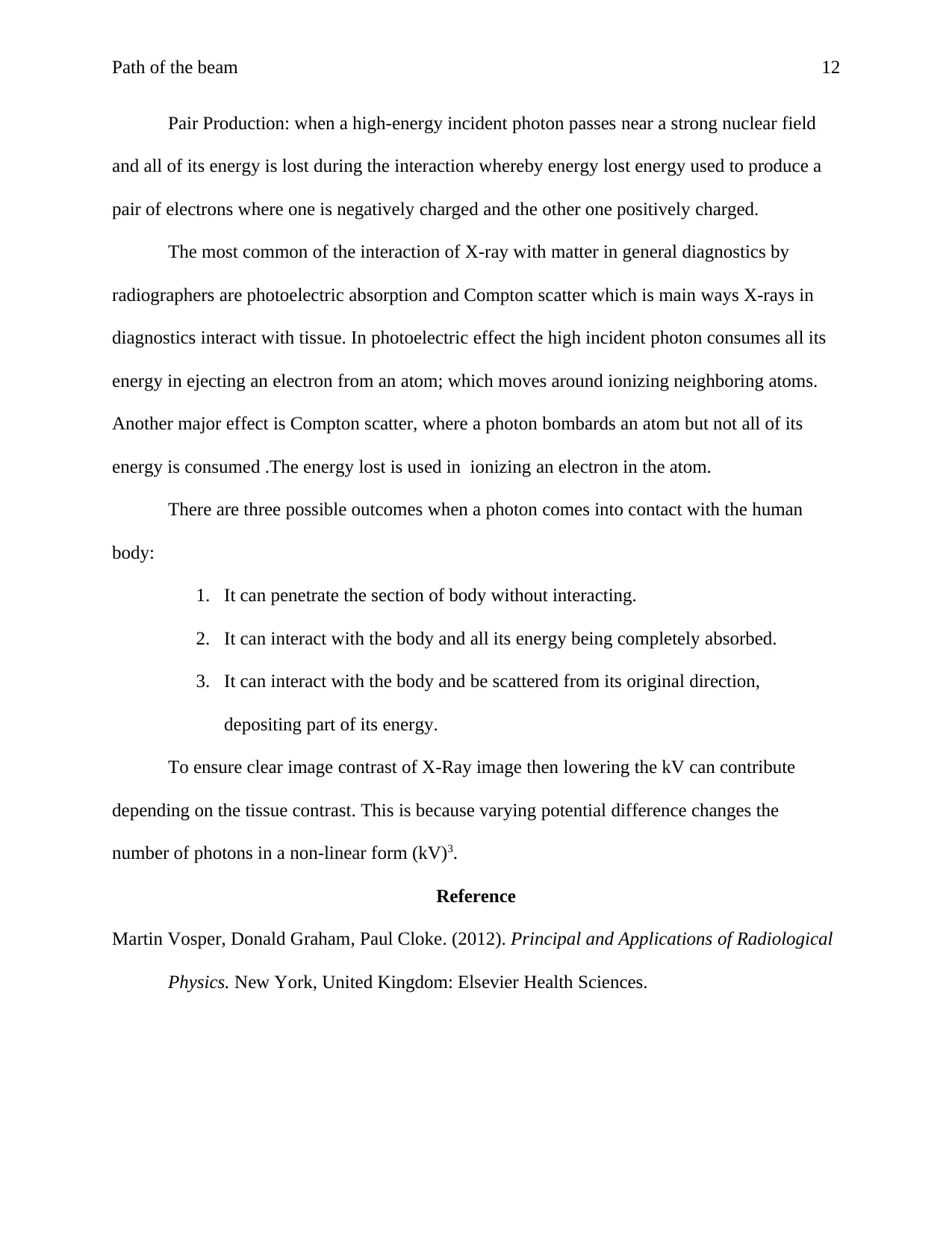
Path of the beam 12
Pair Production: when a high-energy incident photon passes near a strong nuclear field
and all of its energy is lost during the interaction whereby energy lost energy used to produce a
pair of electrons where one is negatively charged and the other one positively charged.
The most common of the interaction of X-ray with matter in general diagnostics by
radiographers are photoelectric absorption and Compton scatter which is main ways X-rays in
diagnostics interact with tissue. In photoelectric effect the high incident photon consumes all its
energy in ejecting an electron from an atom; which moves around ionizing neighboring atoms.
Another major effect is Compton scatter, where a photon bombards an atom but not all of its
energy is consumed .The energy lost is used in ionizing an electron in the atom.
There are three possible outcomes when a photon comes into contact with the human
body:
1. It can penetrate the section of body without interacting.
2. It can interact with the body and all its energy being completely absorbed.
3. It can interact with the body and be scattered from its original direction,
depositing part of its energy.
To ensure clear image contrast of X-Ray image then lowering the kV can contribute
depending on the tissue contrast. This is because varying potential difference changes the
number of photons in a non-linear form (kV)3.
Reference
Martin Vosper, Donald Graham, Paul Cloke. (2012). Principal and Applications of Radiological
Physics. New York, United Kingdom: Elsevier Health Sciences.
Pair Production: when a high-energy incident photon passes near a strong nuclear field
and all of its energy is lost during the interaction whereby energy lost energy used to produce a
pair of electrons where one is negatively charged and the other one positively charged.
The most common of the interaction of X-ray with matter in general diagnostics by
radiographers are photoelectric absorption and Compton scatter which is main ways X-rays in
diagnostics interact with tissue. In photoelectric effect the high incident photon consumes all its
energy in ejecting an electron from an atom; which moves around ionizing neighboring atoms.
Another major effect is Compton scatter, where a photon bombards an atom but not all of its
energy is consumed .The energy lost is used in ionizing an electron in the atom.
There are three possible outcomes when a photon comes into contact with the human
body:
1. It can penetrate the section of body without interacting.
2. It can interact with the body and all its energy being completely absorbed.
3. It can interact with the body and be scattered from its original direction,
depositing part of its energy.
To ensure clear image contrast of X-Ray image then lowering the kV can contribute
depending on the tissue contrast. This is because varying potential difference changes the
number of photons in a non-linear form (kV)3.
Reference
Martin Vosper, Donald Graham, Paul Cloke. (2012). Principal and Applications of Radiological
Physics. New York, United Kingdom: Elsevier Health Sciences.
⊘ This is a preview!⊘
Do you want full access?
Subscribe today to unlock all pages.

Trusted by 1+ million students worldwide
1 out of 12
Related Documents
Your All-in-One AI-Powered Toolkit for Academic Success.
+13062052269
info@desklib.com
Available 24*7 on WhatsApp / Email
![[object Object]](/_next/static/media/star-bottom.7253800d.svg)
Unlock your academic potential
Copyright © 2020–2025 A2Z Services. All Rights Reserved. Developed and managed by ZUCOL.





